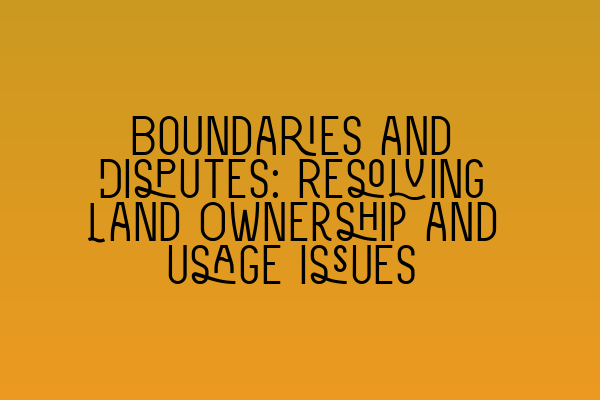Boundaries and Disputes: Resolving Land Ownership and Usage Issues
As a property owner or a potential buyer, it is crucial to understand the concept of boundaries and be aware of the potential disputes that may arise regarding land ownership and usage. Boundaries define the limits and extent of a property, and disputes surrounding them can be complex and challenging. In this article, we will explore the common issues related to boundaries and provide insights on how to resolve these disputes effectively.
The Importance of Clearly Defined Boundaries
Clear and well-defined boundaries are essential for the peaceful coexistence of neighboring properties. They establish ownership rights, prevent encroachments, and provide a framework for land use. However, over time, boundaries can become blurred due to various reasons, leading to confusion and disputes.
Common causes of boundary disputes include:
- Inaccurate or ambiguous property descriptions in legal documents
- Unintentional encroachments, such as fences or buildings extending onto neighboring land
- Disputes over the location of the boundary line
- Disagreements regarding usage rights, such as access to a shared driveway or path
Resolving these issues requires a comprehensive understanding of property law and the ability to negotiate and communicate effectively with all parties involved. At SQE Property Law & Land Law, our team of solicitors specializes in resolving boundary disputes, providing you with expert advice and guidance throughout the process.
The Resolution Process
When faced with a boundary dispute, it is crucial to approach the situation with a calm and rational mindset. Emotions often run high in these situations, but it is essential to prioritize a peaceful resolution for the benefit of all parties involved.
Here is a step-by-step guide on how to navigate through the resolution process:
1. Research and Documentation
The first step in resolving a boundary dispute is to gather as much information and documentation as possible. This may involve reviewing property deeds, surveying reports, and any other relevant legal documents. Having a clear understanding of the historical context and legal rights will help facilitate the resolution process.
Related Article: SQE 1 Practice Exam Questions
2. Open Communication
Initiate open and constructive communication with your neighbor or the party involved in the dispute. Clearly express your concerns and willingness to find a mutually beneficial solution. In many cases, disputes can be resolved through amicable conversations.
Related Article: SQE 1 Practice Mocks FLK1 FLK2
3. Mediation
If direct communication does not lead to a resolution, consider involving a neutral third party to mediate the dispute. Mediation sessions provide a structured environment for all parties to express their grievances and work towards finding a compromise. A professional mediator can facilitate productive discussions and help identify potential solutions.
4. Boundary Determination
In cases where the boundary’s location is unclear or disputed, it may be necessary to hire a professional surveyor to conduct a boundary determination survey. This involves analyzing historical records, conducting on-site inspections, and utilizing modern surveying techniques to establish the exact location of the boundary line.
5. Legal Action
If all attempts at negotiation and mediation fail, legal action may be necessary to resolve the boundary dispute. Engaging a solicitor with expertise in property law is crucial to navigate the complex legal procedures and protect your rights. Your solicitor will guide you through the dispute resolution process and represent your interests in court if required.
Related Article: SQE 2 Preparation Courses
Prevention is Key
While it is impossible to predict and prevent all boundary disputes, there are steps you can take to minimize the risk:
- Obtain a detailed property survey before purchasing a property to identify any potential boundary issues.
- Review and understand all property documents and legal descriptions.
- Maintain open lines of communication with your neighbors and address any concerns proactively.
- Consider establishing a formal written agreement with neighboring property owners regarding shared boundaries and usage rights.
By taking these preventative measures, you can reduce the likelihood of boundary disputes and maintain positive relationships with your neighbors.
Conclusion
Boundary disputes can be highly complex and emotionally charged. However, with the right approach and expert guidance from SQE Property Law & Land Law, these issues can be resolved effectively, ensuring a fair and equitable outcome for all parties involved.
If you are currently facing a boundary dispute or require legal assistance in any property-related matters, do not hesitate to contact us. Our team of experienced solicitors is here to provide you with the professional support you need.
Related Articles:
